
11 minute read
P. Recanati, F. Rovere, O. Jarry.................................................................................................................. pag
Engineering the next generation of carbon based (DLC) coatings for demanding applications
P. Recanati, F. Rovere, O. Jarry
Within the universe of wear resistant thin films, diamond-like carbon (DLC) coatings have emerged as the ideal solution for demanding physical applications where components are under high loads or subject to extreme friction, wear and contact with other parts. In these types of environments, only the high hardness of a DLC coating – along with a corresponding low coefficient of friction – can prevent parts from pitting, galling, seizing and ultimately failing in the field. Coatings within the DLC family can be highly engineered based on hydrogen content (hydrogenated or hydrogen-free), the selection of additional metallic and non-metallic doping elements, the presence of sub-layers and choice of deposition and bonding methods. Together, these factors can be precisely controlled to create a broad range of thin (typically 1 to 5 μm) DLC coatings with a hardness of 8 – 80 GPa. In addition, the desired coefficient of friction, surface finish and even application temperature can also be manipulated.
KEYWORDS:DLC, PA-CVD, LOW FRICTION COEFFICIENT, WEAR RESISTANT COATING, TRIBOLOGICAL COATINGS;
C-BASED COATINGS CLASSIFICATION AND MAIN PROPERTIES Carbon based coatings are listed in regards of the base chemical composition in the VDI 2840 [1] or ISO 20523 [2] standard norms. The next table and pictures are reporting the structures of the naturally present C-C bond types and the wide range which can be obtained artificially in a coating machine.
Fig.1 - Structure of naturally present C and DLC bondings. / Schema delle ( 2) forme allotropiche naturali del carbonio e del rivestimento tipo DLC. Paola Recanati
Product Manager Precision Components, Oerlikon Balzers Coating Italy S.p.A.
Florian Rovere
Market Segment Manager General Engineering Precision Components, Oerlikon Surface Solution AG
Olivier Jarry
Business Development Manager - Advanced Carbon Coatings, Oerlikon Balzers Coating Germany GmbH
Tab.1 - Classification of the carbon films according to the VDI 2840 guideline. [1] / Classificazione dei rivestimenti base carbonio in accordo alla norma VDI 2840.
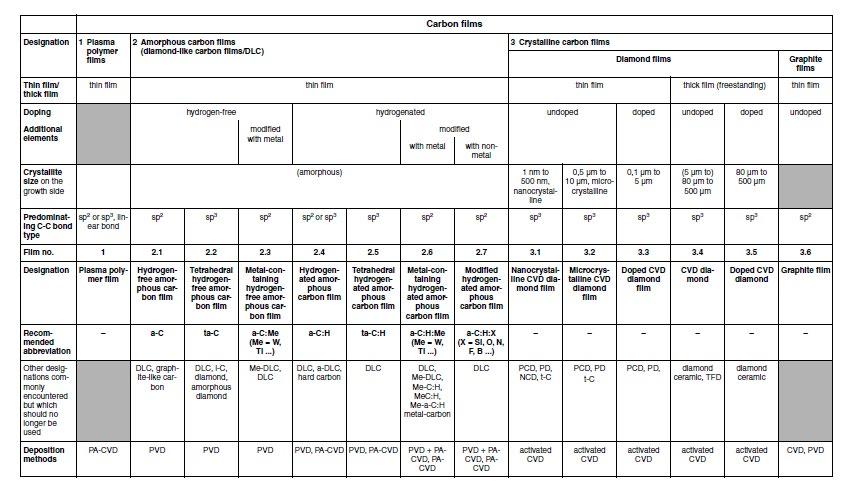
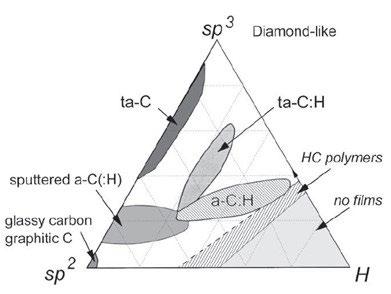
Fig.2 - Ternary phase diagram in amorphous C-H materials [3]. / Diagramma ternario di fase on leghe amorfe C-H.
The most widely known DLC coating type, hydrogenated amorphous carbon (a-C:H), is most often applied through plasma-assisted chemical vapor deposition (PA-CVD). This deposition method causes a chemical reaction through plasma excitation and ionization that creates a coating hardness of approximately 15-30 GPa, which is on the lower end of the DLC family. These coatings can be manipulated further through doping with silicon, oxygen or metals to alter the performance and properties. When a lower coefficient of friction is required for mated or sliding parts, or to assist in releasing items from cavities or molds, silicon doping can be a suitable approach. This creates an a-C:H:Si coating with a coating hardness of 1520 GPa. With silicon and oxygen- doping high electrical resistivity and chemical inertness can also be achieved.
Silicon-doped DLC coatings are often applied to plastic injection molds and ejector pins, blow molding parts and
semiconductor wafer handling equipment.
If the DLC coatings are biocompatible and food-safe, they can be used as the ideal solution for medical instruments and food processing.
When doped with tungsten, a more ductile tungsten carbide carbon (Me-C:H) coating is created that is ideal for gear applications, ball bearings and power transmission systems that are subjected to high surface pressure and where run-in of parts may be required. On the other hand, if a harder surface is required, chromium can be used instead of tungsten.
An alternative to hydrogenated DLC coatings is a family of hydrogen-free based coatings that provide even higher hardness along with a very low coefficient of friction.
The challenge historically with hydrogen-free coatings and with ta-C deposition in particular, is that the application process produces small droplets that contribute to a rougher surface finish. As a result, coating manufacturers must complete secondary polishing processes to smoothen the surface. Because of its hardness, it is a time-consuming and expensive process that requires specialized equipment. To address this concern, some hydrogen-free DLCs are produced using a filtered cathodic arc deposition method in which an electromagnetic filter removes most droplets. Although this creates a smoother surface, a secondary polishing step is still often required, and process times are longer for the same coating thickness. When an even smoother surface is required, hydrogen-free DLC coatings can be applied utilizing a Scalable Pulsed Power Plasma (S3p) technology.
S3p is a unique type of High Power Impulse Magnetron Sputtering (HiPIMS) technology, which can be seen as combining the advantages of the arc evaporation and sputtering methods. The very dense plasma yields hard coatings with high adhesion (at a level comparable to arc evaporation). At the same time, it results in smooth coatings due to the nature of the sputtering process, in which atoms are ejected from a target or source material.
The result is a hydrogen-free DLC coating that delivers a unique combination of high hardness, low friction and a smooth surface. The S3p technology enables the creation of coatings with a high level of “diamond” (tetrahedral) bonds with hardness up to 40 GPa (indentation hardness, HIT). In comparison, conventional DLC coatings have hardness levels in the range of 20-30 GPa for a-C:H and only 10-15 for WC/C.
The coating process operates at a lower temperature than numerous other DLC processes (< 200°C for vs up to 350°C in some cases for conventional DLC coatings). This enables the application of such coating to a much wider panel of materials, effectively bonding to aluminum and steel substrates, which opens up more options for coating applications and also lighter designs to increase performance. The higher hardness directly translates to longer component service life and higher reliability of the component.
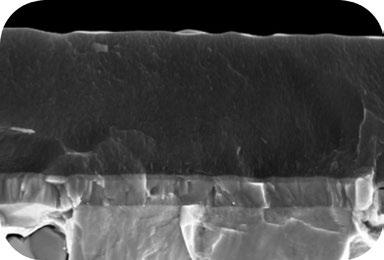
Fig.3 - SEM cross section of a S3p Hydrogen-free DLC / Sezione trasversale al SEM di DLC Hydrogen-free ottenuto con tecnologia S3p.
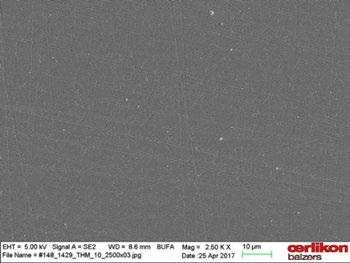
Fig.4 - SEM surface mapping of a S3p Hydrogen-free DLC / Immagine superficiale al SEM di DLC Hydrogen-free ottenuto con tecnologia S3p.
Coating as a design element Given the number of variables involved with DLC coatings, it is important that OEMs better understand the range of options so they can select the ideal solution for the application while also taking into consideration the economics. Coatings are effectively an architecture of layers engineered to achieve specific properties. A coating is built layer by layer focused on bonding, hardness and the surface. By modifying the properties of each, one can create an extremely wide range of surface solutions within the DLC coating family. In the course of the last decades we have collected a wide list of successful case studies in various industries, where only one specific coating solution has successfully solved the tribological system at hand. Carbon based coating such as BALINIT® and BALIQ® coatings cover all the possible coating composition and architecture the market can require.
Tab.2 - BALINIT® coatings properties.
For each of the above listed coatings, a “STAR” version - with a sputtered very ductile CrN supporting interlayer- can be selected to grant the best performances e.g., in cyclic loaded tribo-systems.
Potential applications of C-based coatings Bearings components often suffer from severe and disproportionately distributed abrasive wear. A coating such as BALINIT® C (WC/C) is particularly suitable for case-hardening as well as ball- and roller-bearing steels because it can be applied at temperatures under 200 °C. Similarly, cylindrical roller bearings in compressors are often exposed to low loads and vibrations, causing potential smearing. Applying WC/C coatings to the bearings removes any such possibility. Gears experience similar wear conditions. WC/C coatings significantly reduce scuffing and pitting wear in gears as well. In fact, WC/C coatings have shown to quadruple the service life of high-speed gears. The standard FZG C test shows that the fatigue strength is increased by 10-15% over case-hardened but uncoated gears. In the test, the failure criterion for gear service life
Coating material
Process technology Coating hardness HIT (GPA) Typical coating thickness (µm) Friction against steel, dry running
Coating temperature (°C) Max. service temperature (°C)
BALINIT® C WC/C Sputter 8 -15
BALINIT® DLC a-C:H PACVD ~ 15 – 25
BALINIT® DYLYN a-C:H:Si PACVD ~ 15 – 25
BALIQ® CARBOS a-C S3p® 30 - 40 1 – 4
1 – 3
2 – 5
1 - 4 0.1 – 0.2 < 250 300
0.1 – 0.2 < 250 300
0,05-0,1 180-220 350
0.1 – 0.2 < 200 350
was defined as single-tooth wear of 4% due to pitting. The main factors in these improved figures were the lower local surface pressure (Hertzian pressure), which resulted from reduced friction in the rolling contact, and the superior running-in behavior of BALINIT® C. Coatings can also benefit worm gears, where lubrication is not always enough to protect helical-gear transmissions against friction and wear. Screw spindle-, vane-, gear-, lobe- and centrifugal pumps often function in abrasive and poorly lubricating media. This may be cooling media in grinding machines such as screw pumps and internal gear pumps. BALINIT® coated screws provide the ideal combination of hardness and low friction for preventing wear in such poorly lubricated conditions. Similarly, industrial compressor components, such as reciprocating pistons, screws or valve plates can undergo extensive wear when oil-free operation, dry gases, refrigerants, high or low temperature limit the use of lubricants. In the food and beverage industry, where soft austenitic stainless steels are used widely, environmentally friendly BALINIT® coatings can improve significantly the surface performances without damaging the substrate corrosion resistance, especially when compared to Cr plating. One of the most demanding environments is high performance vehicles. Coatings play a pivotal role by reducing friction and adding surface hardness to ultimately reduce wear. New, advanced carbon coatings such as BALIQ CARBOS, providing unmatched hardness, smoothness and adhesion are going to create a new performance standard in high-wear components in supercars, motorbikes and professional motorsports.
BIBLIOGRAPHY
[1] VDI-Richtlinie 2840, Carbon Films—Basic Knowledge, Film Types and Properties (VDI, Düsseldorf, 2005) [2] ISO 20523 : 2017 Carbon based films – Classification and designations [3] J. Robertson, Mater. Sci. Eng., R37 (2002) 129-281
Nuovi sviluppi e applicazioni dei rivestimenti base Carbonio (DLC)
Nell’ambito dei film sottili ad elevata durezza e resistenza all’usura, la tipologia diamond- like carbon (DLC), per la loro elevata durezza e ridottissimo coefficiente di attrito, si sono molto spesso distinti come la soluzione ideale nei sistemi meccanici ove i componenti si muovono di moto relativo ad elevate pressioni di contatto, quindi ad elevato rischio di usura e grippaggio, che in ultima analisi possono determinarne un precoce fallimento. I rivestimenti base carbonio DLC sono più propriamente definibili come famiglia: contenti o meno idrogeno, dopati o meno con elementi metallici. Possono essere depositati secondo l’architettura più adatta a soddisfare quella richiesta applicativa in esercizio. Ad esempio, la creazione di specifici strati di adesione e/o supporto allo strato funzionale più esterno, può fare la differenza in sistemi sollecitati ciclicamente. Tutti questi fattori, insieme alla tecnologia con cui vengono depositati, possono essere controllati per ottenere una vasta gamma di soluzioni in termini di spessore (tipicamente 1-5 micron), durezza (8-80 GPa), coefficiente di attrito, finitura superficiale e temperatura di deposizione.
PAROLE CHIAVE: DLC, PA-CVD, BASSO COEFFICIENTE DI ATTRITO, RIVESTIMENTI RESISTENTI ALL’USURA, RIVESTIMENTI TRIBOLOGICI;
TORNA ALL'INDICE >
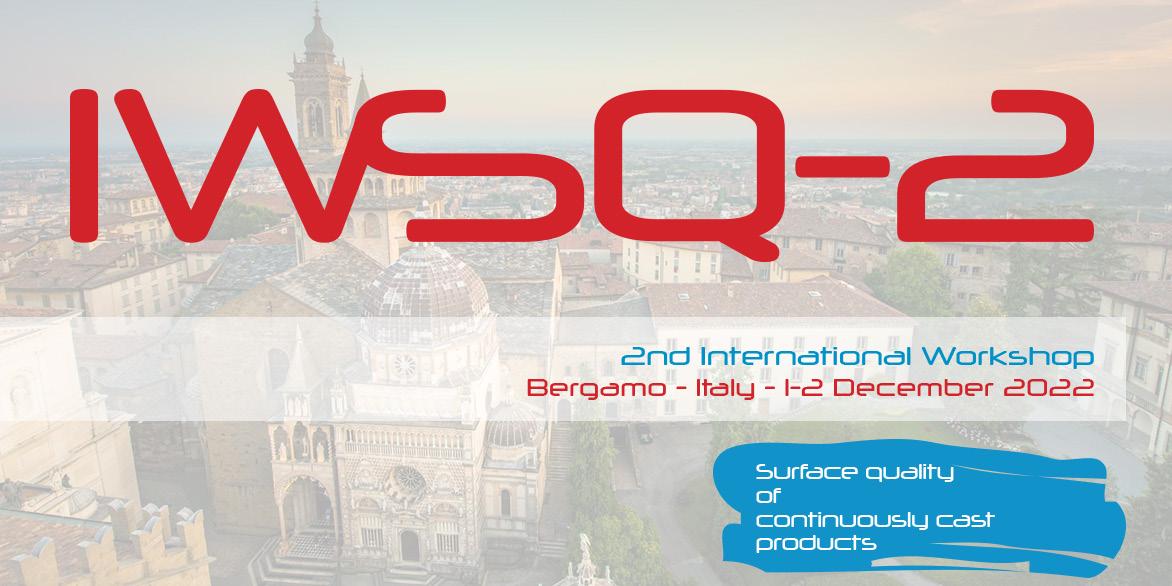
Organised by
Six years after the successful first conference on the topic, AIM, in cooperation with its sister society ASMET, organises once again a two-day event focused on the Surface Quality of continuously cast products. The surface quality of ingots, billets, blooms and slabs is a particularly important issue in order to insure the required surface quality of final rolled and forged products. This aspect is becoming increasingly significant especially nowadays, when a lot of steelmakers are refocusing their activity on the search for better surface quality or new specialty steels requiring high quality surface features. All this lays on a table of new challenges faced by steelmaking industries, when energy efficiency and consequently lower environmental impact are concerned. This international meeting aims at sharing the knowledge about the improvement of the surface quality of the continuously cast products and this scope will be achieved by clear expositions about: • recent advances on the defect analysis; • the root cause of the defects; • innovative lubricating products; • operations and maintenance; • application of electromagnetic devices; • AI applications, simulation and computing methods.
Registrations are open!
The workshop’s programme, featuring several interesting presentations by renowned University and Industry speakers, is published on the workshop website. Register by November 14 for early bird registration fees.
The Conference will be held in Bergamo at the Congress Center Giovanni XXIII, viale Papa Giovanni XXIII, 106 (http://www. congresscenter.bg.it). Bergamo greets visitors with its Venetian Walls. Surrounded by rivers and lush, verdant valleys, crossed by paths that widen to Parco dei Colli, the area’s largest park, the city looks like a lounge filed with art, culture and nature, with a fascinating and complex history just waiting to be shared with others. The “upper and lower” city reveals a mixture of pleasant surprises and unexpected encounters, such as those with Gaetano Donizetti, the great composer of international renown, Bartolomeo Colleoni, the Bergamo leader who served under the Republic of Venice and Lorenzo Lotto, among the most famous Italian Renaissance artists who lived and worked in Bergamo for over a decade.
Associazione Italiana di Metallurgia Via F. Turati 8 - 20121 Milan - Italy t. +390276397770 • t. +390276021132 met@aimnet.it www.aimnet.it/iwsq-2.htm










